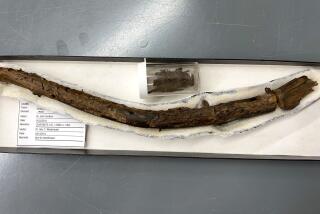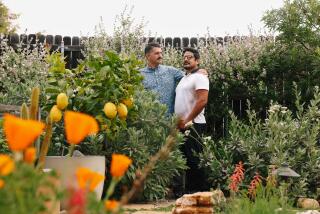Descanso Reinvigorates Its Old Forest of Camellias
Walking across the damp new mulch--a mix of shredded oak, deodars, pines and other street tree trimmings--made a sound somewhere between a squish and a crunch on a soggy day after a winter storm.
This new layer of moist leaves and twigs is helping to invigorate one of Southern California’s premier floral attractions, the forest of camellias at Descanso Gardens in La Canada Flintridge, coming into flower right about now.
It’s the near-perfect place to spend a winter’s day exploring and learning and experiencing the season. Because it’s in a shallow canyon filled with native oaks, Descanso stays moist and chilly, which is one reason lilacs, dogwoods and other cold-climate plants grow here and not in my backyard.
Manchester Boddy, the publisher of the old Los Angeles Daily News, planted the camellias for cut foliage and flowers half a century ago. They’re now a forest of closely spaced small trees, 12 to 20 feet tall, growing under the taller forest of native oaks overhead. Though camellias are usually planted as shrubs, they make great little understory trees.
At Descanso, they’re nourished by leaf litter from the oaks (which also give the camellias a near-perfect soil pH of 5.8) and an irrigation system that collects rainfall from a chaparral-cloaked watershed.
The camellia forest covers about 35 acres, but Boddy wisely bought an additional 280 acres of watershed upslope from his estate gardens, which guarantees some really good irrigation water with enough left over for a recirculating but convincing canyon-bottom creek.
Made in the Shade
A stroll through this shady forest shows clearly why camellias are perhaps our most valuable and useful shade plant. Their glossy foliage is good enough to cut and use in arrangements, the flowers are showy and some bloom for a very long time and they definitely like to grow in shade, unlike so many plants that simply tolerate shade.
Give them too much sun--as a few get in my garden because they have grown too tall and are out of the house’s shadow--and they bloom poorly, the leaves turning yellow from sunburn.
In recent years, Descanso’s impressive forest of camellias began to show a lack of care commensurate with the drop in county funding for this public garden.
Now the gardens are under the care of the Descanso Gardens Guild, and tree seedlings are being hacked out and invasive ivy, which covered the ground and competed with the camellias (and threatened to strangle the oaks), is being dug out. The Descanso forest needed weeding, feeding, mulching and pruning, very much as my own camellias do.
So the work has started, “but we didn’t want to destroy the feel of the forest,” said the new camellia curator, Tim Thibault. Though some of the camellias are slowly being lowered, most will remain as trees.
They are not being “limbed up” (garden jargon for removing the lower branches) as some visitors think, but are merely being opened up so more light reaches interior branches. Gardeners like me with old camellias might learn a thing or two just walking around this forest that’s being freshened up.
“Camellias really take to pruning,” said Thibault, and sure enough, it’s easy to see the new sprouts on some. By cutting just above a lower, smaller branch, pruners can shorten the camellia without disfiguring it and cause new growth on the bare wood below. It can’t be done all at once, but each season the gardeners can make the cuts lower, shortening these very tall old shrubs.
Never do pruners simply cut back the foliage as one would cut a hedge. Proper pruning is one of those garden arts that is very simple once you see how it’s done.
A storm last year flattened some of the oaks; in these clearings, Descanso is planting some of the newest cutting-edge camellias, including some new yellows and those that have fragrance.
Although they’re still young and small, one of the yellow camellias was in full bloom when I was there. The flowers are only a couple of inches across, but they have a double-flowered form and look very fluffy.
It’s a seedling of the species Camellia kissi, named ‘Buttermint,’ and it is a new cultivar from Nuccio’s Nurseries, which has donated many of these new camellias.
None of the yellows approaches chrome yellow yet, but they are definitely not white; nor are they pink or red, the standard camellia colors. The yellow color comes from new species found in Southeast Asia and China.
If you simply must be the first on your block to have one of these yellow camellias, or one of the new fragrant kinds like as ‘Souza’s Pavlova’ or the tiny ‘Minato-no-akebono’ (we reported on the fragrant kinds last February), Nuccio’s is nearby in Altadena. Together, Descanso and Nuccio’s make for a camellia-filled outing.
The new 4-inch-thick mulch should help conserve what water they get. I asked if Descanso gardeners were concerned about the mulch spreading camellia petal blight--the fungus that browns petals. Thibault said it might actually help prevent it. A thick layer can keep the fungus spores from sprouting.
Old-Fashioned Food
The mulch adds some nutrients as well, but surprisingly, in this age of chemical super-fertilizers, they feed the camellias by scattering good old cottonseed meal over the mulch in early and late spring.
The guild is also testing for camellias that bloom for a very long time in Southern California. They’ve already noticed that ‘Showa-no-sakae,’ a soft pink sasanqua; ‘Daikagura,’ a red and white japonica; and ‘Berenice Boddy,’ a two-tone pink japonica, bloom for an extra-long time. ‘Showa-no-sakae’ is the champ, flowering from late August through January.
We’re about in the middle of the camellia season, and there will be plenty of blooms through February and March, which is when most of the big-flowered reticulatas flower, but take my advice and go right after a rain if you want the whole magical forest effect.
More Going On at Descanso
Feb. 1: A guided walk through the camellia forest, 1 p.m. Meet at the center circle.
Feb. 28 and March 1: The Southern California Camellia Council Show, one of the largest in the state, 1 to 4 p.m. Feb. 28 and 9 a.m. to 4 p.m. March 1.
March 15: A talk on reticulata camellias, celebrating the 50th anniversary of their introduction, followed by a walk through the collection, 12:30 p.m.






